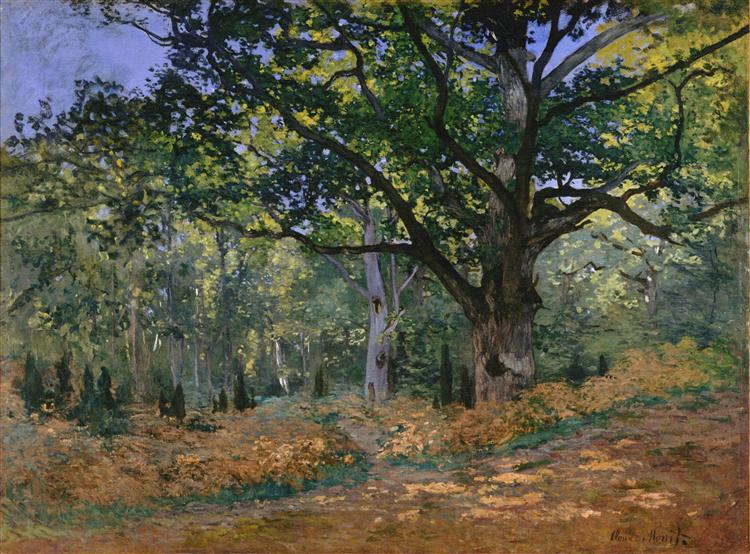Beskrivelse
Værket "The Oak of Bodmer - Fontainebleau" (1865) af Claude Monet er et pulserende vidnesbyrd om kunstnerens talent og en refleksion over hans forhold til naturen. Malet i et landskab, der blev et tilbagevendende tema i hans arbejde, og som ofte fremkalder roen i det franske landskab, viser dette stykke et specifikt øjeblik i udviklingen af impressionisme.
Når man observerer maleriet, tiltrækkes seeren straks af den imponerende egfigur, der fungerer som hovedpersonen i maleriet. Dette træ, malet med tykke slag og en række toner af grøn og brun, stiger stolt i midten af kompositionen og symboliserer naturens majestæt. Monet formår at transmittere strukturen af cortex og densiteten af bladene gennem dens løse og hurtige børstestræk, en teknik, der gør det muligt at fange effekten af lys og skygge, der spiller på træets overflade.
Bunden af værket er sammensat af en række tyndere træer, der omgiver den centrale eg, hvilket skaber en tæt og næsten æterisk atmosfære. De lette spil, der filtreres mellem grenene, tilføjer en næsten magisk dimension til landskabet, der afslører Monets mestring for at fange det flygtige øjeblik af naturligt lys. De blå og grønne toner, der dominerer i baggrunden, kontrasterer med den jordiske brune af egen, hvilket genererer en kromatisk dialog, der styrker træets varighed i lyset af den inkonstante natur af miljøet, der omgiver det.
I modsætning til andre Monet -værker, der ofte inkluderer menneskelige figurer og daglige livsscener, fokuserer "Bodmer's Oak" næsten udelukkende på repræsentationen af naturen. Denne beslutning om at udelade den menneskelige figur kunne fortolkes som et ønske om, at Monet skulle hylde naturens storhed i dens rene tilstand. Arbejdets stilhed står i kontrast til det ophidsede liv i de omkringliggende byer og byer og tilbyder et visuelt husly, der inviterer til kontemplation.
Det er også interessant at nævne, at Bodmers eg ikke kun var et emne af interesse for Monet. Dette træ blev en slags ikon inden for den tids kunst og art, og Monet, når han valgte dette emne, tilpasset en tradition for landskab, der forsøgte at fange essensen af genkendelige og beundrede naturscenarier. Maleriet er indskrevet i den bredeste kontekst af søgningen efter kunstnerisk ægthed og forbindelse med den art, der karakteriserede den impressionistiske bevægelse.
Dette billede sammen med andre moderne værker af Monet, såsom "Impression, Rising Sun" eller dets serie på nenoufares, illustrerer dens udviklede forståelse af lys og farve samt dets engagement i teknikken til "maleri udendørs". Oplevelsen af at se og fange subtiliteterne i naturligt lys er det, der definerer den impressionistiske stil, og "Bodmer's Oak" er ingen undtagelse.
I sidste ende står "Bodmer's Oak - Fontainebleau" ikke kun som et mesterværk inden for Monet -repertoiret, men også som en påmindelse om naturens betydning i kunsten og en invitation til at genoverveje vores forhold til den naturlige verden. Monets evne til at omdanne et simpelt landskab til et fængslende visuelt husly resonerer stærkt i dette maleri og inviterer seeren til at gå tabt i sindsroen af arven på lærredet.
KUADROS ©, en berømt maling på din væg.
Håndlavede olie -malerier med kvaliteten af professionelle kunstnere og den karakteristiske segl af KUADROS ©.
Billeder reproduktionstjeneste med tilfredshedsgaranti. Hvis du ikke er helt tilfreds med kopien af dit maleri, refunderer vi dine penge 100%.

